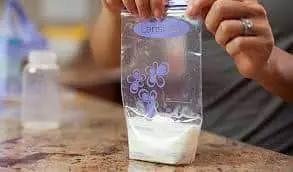Storing breast milk can eliminate one of the few perceived disadvantages of breast feeding, restriction. While a bottle-fed baby can be left with another family member while you’re free to do other things, a breast fed baby is tied to the breast, literally. By pumping, storing, and then bottling breast milk, your breast fed baby can be bottle fed. This is especially helpful for travel, work, attempting to increase breast milk supply, and/or any other situation that requires breast milk without your breast present.
This simple step-by-step guide on storing breast milk will cover the safety precautions, do’s and don’ts of, and the process of storing breast milk for later use.
Refrigeration of breast milk:
For short term storage of breast milk, refrigeration is the best route to take. Breast milk does need to be kept cold or like cow’s milk it will spoil. Breast milk does, however, spoil less quickly than regular milk due to the antibodies that are present within it. These same antibodies are what make breast milk so healthy for your baby.
Breast milk will keep three to four hours at room temperature and three to five days in the refrigerator. If you aren’t sure you’ll use the milk in this time period, it should be frozen.
Storing breast milk in the refrigerator:
-Pump and label the milk with a clear date including day, month, and year.
Once pumped, breast milk should be stored in sterile, air-tight containers. To prevent waste, use containers the average size of one feeding for your baby. This is typically two to four ounces.
-Place in refrigerator kept within the temperature ranges of 32 F to 39F (0-3.9 C)
Don’t keep over five days at the most.
Freezing breast milk:
Freezing breast milk allows for longer-term storage and bulk reserves. This is useful in the event you become ill or require medication unsafe for breast feeding, because a stock pile of milk in the freezer allows breast feeding to continue safely during this time. As a note, if you will be feeding stored milk rather than breast feeding for any extended amount of time you will need to continue to pump and dump to retain milk supply.
Freezing breast milk does destroy a certain amount of the antibodies within the milk, however, it’s still healthier than formula. Frozen breast milk will keep up to even a year if kept in the proper temperature range.
Storing breast milk in the freezer.
-Pump and label milk with a clear date.
When packaging breast milk for freezing be sure to leave some room at the top of the container as frozen liquids expand. You may find bags more convenient than plastic tubes, because they stack easily and are less prone to crack.
-Store the milk in the following temperature ranges for desired store times.
*Two to four weeks: Can be kept in a freezer compartment within the refrigerator that has a temperature below 32 F.
*Three to four months: Can be kept in a freezer unit connected to a refrigerator with a temperature range below 0 F.
*Six months to one year: Must be stored in deep freeze. Temperature should remain below -19 F. Do not store in door.
Stored breast milk will have a different appearance than fresh milk. This is normal. The milk will separate and have layers. Thawed milk also sometimes tastes or smells soapy. This is due to the break down of fats and is also normal. Most babies don’t mind this. If milk smells rancid or you question whether its good, it’s better to throw it away.
Re-heating Breast Milk:
Frozen milk is best pulled 24 hours in advance and left to thaw in the refrigerator. It can also be run under warm water to decrease thaw time.
Breast milk shouldn’t be reheated in the microwave. This is not only because the heating destroys some nutritional content of the milk, but because it creates hot spots and heats the milk unevenly. You can use a breast-milk warmer or simply warm some water on the stove and place the bottle within it to reheat the milk. Don’t bring breast milk up to the boiling point. Always be sure to test the temperature of the milk on the underside of your wrist before feeding it to your baby.
After the initial re-heating any remaining breast milk can be kept in the refrigerator for no longer than twenty four hours, it shouldn’t be refrozen and should be thrown away after the 24-hour mark.

